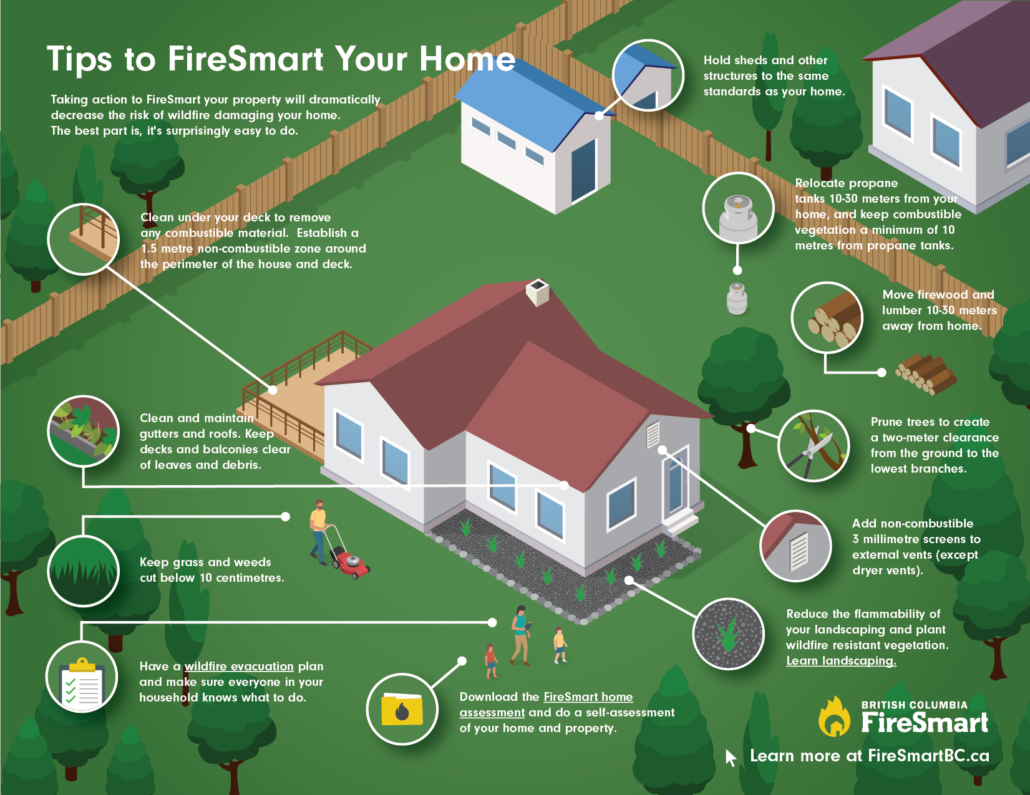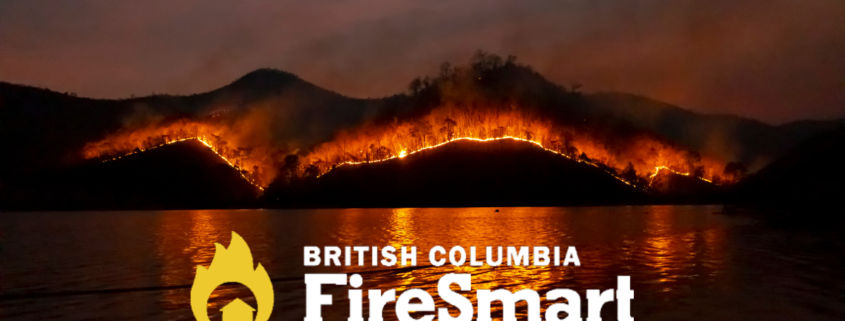FireSmart in Fall and Winter for Summer Wildfire Protection
The next wildfire season will be here before you know it! Prep your home – get FireSmart in fall and winter.
Another wildfire season will be just around the corner. Do you think your home and property are prepared? If not, don’t feel discouraged. You can get FireSmart in fall and winter – easier than any other time!
If you aren’t familiar with the program, FireSmart™ helps us to more effectively live with and manage wildfires in our communities and on our property. It gives us the tools and information we need to become more wildfire resilient and share that responsibility with our neighbours and larger communities. It’s an all-encompassing program, that helps individual homeowners take on greater land management to protect their homes and properties.
And just because wildfire season is over in British Columbia and the cold weather is on its way, it doesn’t mean we have to wait till spring to prepare. In fact, to FireSmart in fall and winter is probably the best – and easiest – time to get ahead of it.
Wildfire – the anatomy
We know that wildfires need fuel to expand. To overtake an area, fire will consume everything in its path – from trees, shrubs, and grasses to structures themselves, if not protected. Some fuel – the surrounding vegetation – is more potent and flammable than others.
Look around your yard and notice the types of trees that surround your home. You may see coniferous trees, such as fir and junipers. They will pose a greater fire danger than deciduous, or leafy, trees that are significantly less flammable.
In addition to fuel, the wind and even the wildfire’s energy can toss burning embers and debris up to two kilometres ahead of its path. Burning, airborne embers eventually drop to ignite anything they land on, including the ground, vegetation, and, of course potentially your home. These embers can cause serious damage as they burn and gain momentum. Because, inevitably, they too will launch ignited debris into the air to propel the wildfire further into the area or surrounding community.
How to FireSmart in fall and winter
According to Natural Resources Canada (NRC), they estimate that over the past three decades in Canada, wildfires and forest fires have destroyed about 2.5 million hectares (as many as 6 million football fields) each year. Fire suppression resources alone have cost approximately $500 million to $1 billion every year.
Given the profound damage fires cause each year, and as they become more and more prevalent, it’s vital you do as much as you can to protect your home and property. Thanks to the FireSmart program, there’s a comprehensive guide and resources available to maximize the fire resistance of your property to help reduce the likelihood of damage and loss.
As the number of devastating wildfires increases throughout British Columbia and our region, education is critical. In answer, FireSmart Canada offers a FREE online course, to guide homeowners and communities to better prepare against wildfire.
Take the FREE FireSmart 101 course!
Below are a few easy things you can do now and throughout the fall and winter to prepare and protect your property long before wildfire season next year.
Look at your yard!
FireSmart begins in your yard. Take stock of your landscaping – grasses, trees, shrubs, plants, and mulch – and identify those that might pose a fire hazard. There may be better options in landscaping materials that protect your property and still look nice. Look for those plants and landscape materials that offer fire resistance.
A FireSmart yard is comprised of primarily lower-profile (close to the ground), less flammable or combustible plants and shrubs that are adequately spaced. Remove any wood debris that is close to your home, including mulch that might be hospitable to burning embers.
Maintain a ‘non-combustible zone’ around your home. This zone will be 1.5-metres wide and contain more stone, rock, and soil than plants or wood debris.

Evaluate your surrounding landscape
Consider the vegetation and landscaping materials that surround your home. Identify if it is flammable or fire-resistant. Flammable plants tend to have:
- aromatic needles or leaves
- oils or resin
- loose, papery or flaky bark
- fine, dry, dead material accumulation at the base
Fire-resistant plants have:
- supple, moist leaves
- minimal sap or resin material
- sap that is water-like and has minimal odour
- little or no accumulation of dead or dry vegetation at the base
What is the state of your grass? Mow frequently and keep your lawn shorter than 10 centimetres to help with fire resistance. Dry, longer grass tends to be more flammable. During the summer months, keep your lawn well-watered as best you can. But, wherever possible in your yard, try to reduce irrigation demand. Choose more plants that are drought-resistant.
Look at the ground. Do you use bark mulch? Is there an accumulation of pine needles? They are highly combustible materials, so as much as possible, try to keep them beyond 10 metres of your house or other structures. If you want to mulch your yard, choose fire-resistant mulch materials such as crushed rock or gravel.
Many of us use wood to heat our homes. Be sure that your woodpile is situated away from your house – stacks of dry wood poses a significant fire hazard! Additionally, be sure that your woodpile and chopping block is tidy and kept free of bark and wood debris as best you can.
Check your trees and shrubs
Of course, we love the trees in our yard! There’s nothing like being surrounded by greenery and nature – it’s why we live here! We want you to enjoy your trees – and be FireSmart. You can have a treed yard and still be fire-resistant. Instead of evergreens, plant leafier, deciduous, trees. Consider trees such as maple, poplar, birch, aspen, alder, cherry, ash, or cottonwood.
If you have or enjoy coniferous trees, it’s best to not have them within 10 metres of your home and keep them very well spaced (at least three metres apart). These trees include fir, pine, spruce, cedar, and juniper (super flammable!).
Keep in mind that when coniferous trees ignite close to your home, the intensity of heat is enough to set fire to your house. Once the fire is in the tops of coniferous trees, it easily advances from tree to tree – intensifying as it travels.
As you FireSmart in fall and winter, thoroughly clean and tidy any debris from around your house. Specifically, remove the flammable materials such as dry leaves, twigs, and branches. Get rid of those smaller coniferous trees as they ignite easily and fast. The smaller trees can provide a ‘ladder’ giving a fire an easy way up to the top of the tree where it can more easily leap.
Winter, or the dormant season, is the ideal time to prune trees. In fact, winter pruning is recommended and makes for healthier trees and shrubs come spring. When it comes to fire, dead or damaged branches can provide a fast and easy way for the fire to move from the ground to the upper limbs. Keep dead, dried materials and debris clear of the base of the trees.
Learn MORE about making your home FireSmart!
Questions about your home insurance coverage and how you’re protected in the event of a wildfire? TALK TO US!



